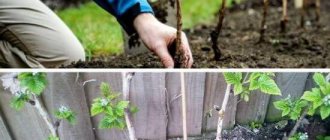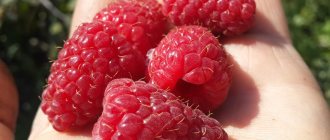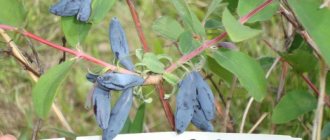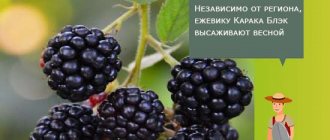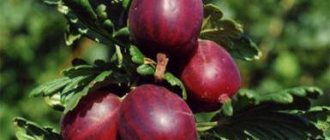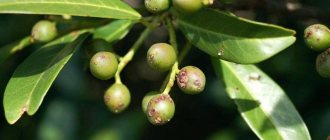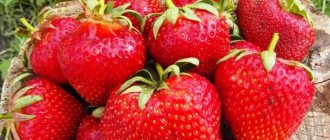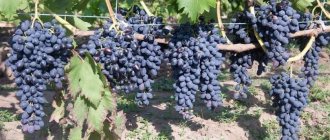Initially positioned as ultra-early, in fact it turned out to be closer to the average, dessert taste - Brzezina blackberries (or Brzezina - there are discrepancies) could break all records of popularity of the blackberry assortment. But something went wrong.
Either they didn’t have time to figure it out - after several years it’s difficult to give an objective assessment of culture, or they underestimated it, or they were hasty in drawing conclusions about its originality - until it became widespread.
There are chances: the variety is relatively new, and farmers have the opportunity to draw conclusions. In the meantime - description, detailed characteristics, opinions and reviews of breeders and those who are not indifferent to the gifts of Polish selection.
Obtained in the experimental laboratories of the famous Institute of Horticulture in Brzezne, breeders Jan Danek, Agnieszka Orel. Patented in 2012. Complex hybrid, carries the Black Satin x Darrow genes, famous for productivity and taste. Used in horticulture, commercial cultivation.
In Poland it ripens in early July, in Ukraine and Russia a little later - in mid-early July, at the end - depending on the region.
The description initially indicated extra-early dates as a guide, 10-14 days earlier than the traditional early ripening Loch Tay. In fact, the first Brzezina berries ripen at the same time.
We can only hope that young plants have a later first flowering after flowering, as well as more sparse fruiting - it is no coincidence that it is called a signal. In addition, it is worth making allowances for differences in climate.
Reveals potential 3-4 years after planting.
Morphological description of the variety, characteristics
- The bush is semi-creeping, medium-spreading, powerful, voluminous, high growing vigor. The shoots are well branched, thick, and there are no thorns. At the initial stage of growth, the vine is light green, but by autumn it takes on a brownish tint.
- In the first year it produces one or two replacement shoots, and subsequently the shoot-forming ability is excellent.
- The fruit branches are not long, with many multi-berry clusters.
- The leaves are light green, of a characteristic delicate shade, with sharp small teeth.
- It does not produce many root shoots; more numerous shoots are observed after damage to the root system.
- The fruits are intense black with a lacquered sheen, elongated, large and medium-sized. The average weight is 5-6 g, large ones are 7-9 g. The density is sufficient, the taste is pleasant - moderately sweet, with a characteristic blackberry sweet and sour aftertaste. Despite the declared heat resistance, the berries bake in the sun.
- Resistant to major diseases, tolerant to pests.
Positioned as frost-resistant and not requiring shelter. With an amendment - for the milder Polish climate, where most varieties overwinter without shelter.
In the climate of Ukraine and Russia, they need protection from frost using the traditional method: plants are removed from their supports, covered with agro-fabric, vegetable mulch, and other shelters are constructed from available materials - boxes, etc.
Of the minuses: Positioned as an ultra-early variety, the Brzezina blackberry variety did not live up to expectations, turning out to be mid-early ripening.
Perhaps this is due to differences in the climatic conditions of Poland and Ukraine, Russia, and Belarus. As for fruits baking in the sun, this annoying phenomenon occurs in many forms.
Just as it is impossible to draw clear conclusions, it is also difficult to characterize the characteristics of growing a variety. Judging by Polish sources, care differs little from care of all semi-cresting representatives of the species.
Planting is carried out according to a relatively sparse pattern - at least 2-2.5 m between plants.
Planting is carried out in spring or autumn, planting material is usually seedlings in containers, multiplates, often in vitro.
When planting in autumn, it is important not to disturb the clod of earth, so as not to expose the young white roots - this is fraught with freezing and poor wintering.
In May-early June, the tops of young shoots are pinched to stimulate lateral branching.
If you want to propagate a variety, this will speed up the process: more material for rooting.
The photo shows blackberry Brzezina (aka Brzezina), a side shoot.
They organize supports - the height of the trellis is 2-2.5 m, stretch three rows of wire (two are possible). To prevent sagging of the branches of the lower tier, you can stretch a wire nearby at a height of up to 50 cm to lay the laterals.
Propagated by shoot tips, root division, and less often by root cuttings due to their small number. The tops should be rooted no later than the beginning of September.
Standard fertilizing is a nitrogen-mineral complex, before flowering, at the stage of ovary formation we focus on the mineral complex - potassium, calcium, phosphorus, iron, boron, manganese and other microelements available in many complex fertilizers are definitely needed.
The vine that has given up its harvest is removed from the supports before it is completely lignified - this will make it easier to fold it for a compact shelter. When negative temperatures approach, they are covered with agrofibre; in the absence of it, they are mulched with plant residues, covered with boxes, etc. It is important to prevent the roots from getting wet and rotting - this leads to lunges.
In early spring, remove the cover - preferably gradually, so that the vine gets used to the intense spring sun.
That is why gardeners are often in no hurry to lift plants onto a trellis, even though the air is much warmer than the soil, but the green mass that has wintered under cover does not react well to intense ultraviolet radiation.
Reviews
The laudatory advertising odes, which were very hasty, served an evil purpose: having failed to live up to expectations, the variety was automatically recorded as unsuitable. This is wrong. According to a few owners, Brzezin's blackberries have received good reviews. The potential is encouraging - growth vigor, abundance of fruit branches, fruit size.
The bushes quickly gain volume, the shoots are not brittle, quite flexible and strong.
The taste is decent - not out of the ordinary, not exclusive for a gourmet - gentle, pleasant, calm, moderately sweet without a piercing, intrusive acid.
According to reviews, those who do not like to set their teeth on edge and at the same time cloyingly sugary will like it - light, unobtrusive, appetizing - typical blackberry. It is difficult to talk about the complexities of agricultural technology and the peculiarities of care - it takes time to draw conclusions.
About proven and productive varieties:
We can only hope that the new product, owned by the selection ace Jan Danek, who gave the world many masterpieces, will take root in our fields and gardens and will please us with a generous harvest as a reward for our patience.
In total, there are more than 400 cultivated varieties of blackberries in the world, but not all of them produce large, juicy and sweet berries. To choose the right variety, gardeners have to carefully study thematic publications and catalogs. In recent years, many new products of Polish selection have appeared on the agricultural market. Among them is the Brzezina blackberry, a young but very promising hybrid variety that our gardeners have not yet had time to appreciate.
Description of the variety
Blackberries Brzezina are registered as an early ripening variety. However, it is worth making allowances for differences in climatic conditions in different regions. For example, in the mild Polish climate, Brzezina can produce the first harvest in early July, and in central Russia and Ukraine - one to two weeks later.
Distinctive features of the variety are great growth vigor, absence of thorns and large berries with high taste. The fruits of Brzezina blackberries are quite dense, with a pleasant taste. They are not bitter, not cloyingly sweet, but have a pleasant sourness. The taste of the berry is rated 4.6 points out of 5. The average weight of the fruit is 5–6 g, and some berries reach 7–9 g. The total yield for the entire fruiting period of the bush fluctuates within 8 kilograms.
Brzezina blackberry seedlings are usually sold with a closed root system
The fruits of this variety have an exceptional presentation. They have a slightly conical elongated shape and are painted in an intense black color with a characteristic shine. These blackberries are in steady demand among buyers.
Dense clusters are formed on the shoots of Brzezina blackberries, which makes harvesting easier
In appearance, Brzezina blackberry bushes are not much different from other varieties. Fruiting, like most forms of cultivated blackberries, begins in the second year after planting. In the first year, the shoots grow quickly, are well covered with leaves, but do not form flowers. In the spring of next year, numerous flowers appear on last year's shoots, and already in the second half of July the first ripe berries appear.
The maximum development of Brzezina's varietal qualities is observed only in the third year after planting, when the plant begins to bear fruit steadily. With proper agricultural technology and proper care, Brzezina will thank the gardener with an excellent harvest of aromatic berries.
The Brzezina blackberry bush has well-branched shoots with many berry clusters
The variety belongs to tall shrubs, reaching a height of 3 meters. As a rule, gardeners, for ease of harvesting, do not allow shoots to rise more than 2 meters in height, so the plant needs annual pruning. Brzezina almost does not form shoots, but if the root system is damaged, the number of root suckers increases.
Young shoots of Brzezina increase in strength in the first year, blackberries begin to bear fruit only in the second year
Blackberry Brzezina is a hybrid that has a wide range of benefits. But this blackberry has its own characteristics, which are important to consider when planting and growing.
Table: advantages and disadvantages of the variety
| Advantages | Flaws |
| Frost resistance | Abundant fruiting is observed only in the third year |
| High yield in the third year of fruiting | Small number of root shoots |
| Early maturation | Berries are baked in the sun, despite the declared heat resistance |
| Resistance to most diseases | Needs shelter in winter |
| Rarely affected by pests | |
| High transportability of fruits | |
| Pleasant taste and dense berry structure |
The taste of blackberries depends on the place where they are planted. In the shade, the bushes develop poorly; due to lack of light, the berries may have excessive acidity. However, plants exposed to the sun often suffer from a lack of moisture, which leads to poor development of the ovaries. In hot weather, Brzezina fruits bake in the sun, although breeders initially stated that this was unusual for the variety. It is worth noting that other cultivated varieties of blackberries suffer from the sun in hot summer conditions. This must be remembered when planning the future harvest.
The Brzezina variety is distinguished by abundant fruiting, but the peak yield occurs only 3–4 years after planting
The experience of gardening farms has shown that Brzezina needs to be covered for the winter, especially in the first years after planting. In the southern regions, this variety can grow without shelter.
How to water blackberries correctly
The Brzezina variety loves moisture. But overdoing it means causing mold to appear. The watering algorithm depends on the age of the blackberry. Young plants are watered 1-2 times a week.
The condition of the soil is first checked to prevent waterlogging. The bottom layer under the mulch is examined, as it is used to retain moisture for a long time.
Mature blackberry bushes are watered frequently. Especially in hot weather. After rains, the procedure is not carried out, as there is a risk of infection with a fungus, and a tendency to decrease the plant’s immunity develops.
Features of growing blackberries of the Brzezina variety
Blackberries have long become a common crop in summer cottages, but for its successful cultivation it is necessary to follow the rules of agricultural technology. Otherwise, you may not only not expect high yields of tasty berries, but also completely ruin the young seedlings.
Planting blackberries
When choosing a place to plant blackberries, you should look for a cozy corner on your site, protected from the winds, with good lighting. It is best to install a blackberry trellis along the fence on the south side of the house. A high fence will protect the plants from too hot sun and possible gusts of wind.
The right place for planting blackberries is the key to abundant harvests.
Planting can be in autumn (September - October) or spring (April - May). Plants planted in autumn should be well established before the onset of persistent frosty weather. When planting in spring, rooting occurs much faster than in autumn, but here it is also important to respect the timing.
Autumn planting of blackberries should be carried out 2–3 months before the onset of persistent frosts.
Blackberry planting material is most often seedlings with a closed root system. Some sellers sell planting material with bare roots; this is acceptable when transporting seedlings over a short distance. In any case, the root system must be preserved as much as possible when planting in the ground.
If you are going to plant seedlings with an open root system, you can dust the roots with growth-stimulating preparations (for example, Kornevin).
Step-by-step instruction
- Before planting, dig a trench 30 centimeters deep.
The depth of the trench for planting blackberries should be slightly greater than the bayonet of a shovel (about 30 cm)
A blackberry seedling planted in a trench is sprinkled with soil and watered well.
The soil can be anything, but blackberries grow best on slightly acidic and light soils. There is no need to apply special fertilizers to the soil, but in the spring it is recommended to fertilize with a complex of mineral fertilizers. You can scatter the granules near the bushes or pour liquid fertilizer under the roots (depending on the type and method of application of the complex). This will help the plants quickly recover after winter and receive all the necessary elements for active growth.
Video: planting blackberries with a closed root system
Features of care
Brzezina is resistant to diseases and pests, so it should not be treated unnecessarily with insecticides or antifungal drugs. At the flowering stage, it is recommended to feed the blackberry bushes with a nitrogen-mineral complex, and during budding - with a mineral complex fertilizer.
The soil under blackberry bushes should always be moist. In order to retain moisture well, you need to mulch the soil with peat, humus or sawdust.
Although Brzezina is a frost-resistant variety, it is still worth playing it safe and tilting the shoots towards the ground, covering them with agrofibre, cardboard or other covering material. This way the bushes will overwinter well and will not be damaged by frost.
Blackberry bushes should be covered with agrofibre or other covering material for the winter.
Blackberries of this variety reproduce well by dividing the root system, layering and cuttings. To get good seedlings, the tops of the shoots need to be dug in for rooting no later than the first ten days of September.
Preparing for winter
Since winter can be unpredictable in terms of temperature, the best solution is to cover blackberries, despite their frost resistance. Older and stiffer branches that can no longer be bent to the ground must be tied to a trellis and wrapped in agrofibre. Young shoots are elastic, and they can be easily bent down and covered with agrofibre in the same way, but already close to the ground. It is worth laying straw or sawdust under the branches - this will help additionally retain heat for the plant.
Picking berries and methods for storing them
Brzezin blackberries are harvested as they ripen. As a rule, they ripen in waves, very unevenly - this is both an advantage and a disadvantage of the variety. On the one hand, it is necessary to constantly monitor the harvest and pick ripe berries on time, on the other hand, gardeners have the opportunity to feast on fresh fruits until the first frost.
The high keeping quality of the Brzezina variety makes it possible to preserve berries without loss of taste for up to four days. Fresh fruits should be stored at temperatures from zero to three degrees Celsius. Blackberries are ahead of raspberries in their chemical composition, and when properly stored, they retain their beneficial properties to the maximum.
Before storing blackberries, do not wash them! The skin of the fruit is very thin, and the berries release juice quickly.
Blackberries of the Brzezina variety are characterized by good transportability
Advantages and disadvantages
The main advantages of the plant include the following:
- large and tasty fruits;
- a large number of fruit ovaries and excellent yield parameters;
- good transportability - associated with sufficient elasticity of the pulp;
- high resistance to frost - the crop can withstand temperatures down to -25 degrees;
- the absence of thorns makes harvesting much easier;
- resistance to diseases and pests.
At the same time, culture also has certain disadvantages. The plant did not justify itself as an ultra-early variety. In the middle zone and in colder regions, crops need to be insulated for the winter.
Reviews from gardeners
I carried out the opening and garter of Brzezina, the bush was one year old in May, overwintered well under agrofibre (50), strong growth, even outstripped the two-year-old Logtey, gave 6 bushes, very beautiful, more could have been done, but did not strain, there are already a couple of replacement shoots, neat we need to open it, we’re waiting for the berries, it responds well to feeding, it’s a favorite, something like this.
Varava
https://forum.vinograd.info/showthread.php?t=8952&page=7
'Brzezina' (clone 98564) is a new thornless variety, the earliest variety of Polish selection. The berry is large and medium, transportable.
Yuri-67
https://forum.vinograd.info/showthread.php?t=8952
In the fall I received Brzezina. I took it home for the winter to grow. When 2 branches of 50 cm each grew, I buried them in pots and got 2 seedlings, after which I buried the cut branches again. After ten days I checked - callus and root primordia had formed again
aleksandrponomar
https://forum.vinograd.info/showthread.php?t=8952&page=2
Judging by the reviews, Brzezina blackberries are a promising variety that reveals its full potential only in the third or fourth year of fruiting. It is during this period that peak yields occur. The variety is characterized by increased resistance to diseases and pest damage. Agricultural technology is quite simple, so even the most inexperienced gardener can cope with planting and care. In the future, Brzezina will be able to successfully take root in summer cottages and gardening farms.
Blackberries cannot be called an exotic berry. Everyone knows it, many have tried it. But unlike raspberries, which grow on almost all personal plots, blackberries have not become widespread in Russia and the countries of the former USSR. But times are changing, thanks to the Internet, television and print media, domestic farmers find out which crops are grown and bring big income abroad.
It turns out that blackberries are among the most popular berries. It doesn't have to be sour and prickly. There are varieties that are thornless, productive and very tasty.
Treatment against diseases and pests
Despite the fact that Brzezina blackberries show good immunity to various diseases and pests, there is a possibility of infection of the plant. To avoid crop loss and deterioration in the health of the bush, it is necessary to carry out regular preventive procedures. As a preventive treatment, every spring it is necessary to spray the bushes with preparations that contain copper.
These include:
- Bordeaux mixture . Helps prevent infection by rot and late blight, and also saves plants from various types of spotting;
- HOM is a fairly common drug used to treat plants in open ground and greenhouses. It is based on copper oxychloride. The drug allows the plant to cope with fungal infections by strengthening the immune system;
- copper sulfate is a proven remedy that does not have a cumulative effect;
- Abiga-Pik is used for those bushes that are grown in open ground. It can be used in combination with other drugs, and it does not affect the soil and neighboring plants.
All medications must be used in accordance with the manufacturer's instructions.
History of selection
The garden blackberry variety Brzezina was bred at the Polish Institute of Horticulture, located in the city of Brzezina. Its authors are Agnieszka Orel and Jan Danek. The parent varieties of Brzezin's blackberries were the famous Black Satin and Darrow.
The tasks of Polish selection are somewhat different from those of North America. Overseas, the priority is to obtain varieties with excellent taste, even at the expense of yield. Polish scientists set the task of breeding easy-to-care blackberries that do not require shelter for the winter. True, good taste matters too.
The Brzezina variety is one of the newest. It was registered and patented in 2012, but went on sale only in 2015.
Description of the berry crop
The Brzezina variety has not yet reached its potential. Three years is too short a period to talk about compliance with the description given by the breeders. Perhaps this is why gardeners’ reviews of Brzezin’s blackberries are somewhat different from the properties stated in the patent. It is possible that climatic features also played a role here.
General idea of the variety
Blackberry Brzezina forms a powerful bush with semi-creeping shoots. Young ones are light green, turning light brown as the wood matures. In the first year after planting, 1-2 shoots are formed; subsequently, the shoot-forming ability is very good.
There are no spines, the fruit branches are short and numerous. Brzezina blackberries reach fruiting age at three or four years. By this time, its shoots become thick, stiff and grow up to 3 m. They do not bend very well, which makes shelter for the winter difficult. A lot of side branches are formed, which is why the Brzezina bush looks massive. On the contrary, there are few offspring suitable for reproduction. To increase their number, the blackberry root is specially damaged with a shovel bayonet.
The leaves are delicate green in color, with numerous teeth. The root system is well developed. Fruiting occurs on the growth of the previous year.
Berries
The fruits of the Brzezina blackberry are collected in numerous clusters. Each bears approximately 10 berries. Poles are creating varieties suitable for commercial cultivation. Therefore, Brzezin blackberries are dense, beautiful and tolerate transportation well.
Since the variety is new, gardeners cannot say with certainty what the fruits will be like when it reaches its full potential. But the signal specimens look promising. The size of Brzezina berries is not equal - on one bush there are fruits of 5-6 g and 7-9 g. Some foreign sources claim that as the blackberries mature, their weight will increase to 8-12 g. Time will tell.
The color of the fruit is black, with a characteristic shine, the shape is oblong, similar to Karaka Black, but much smaller in size. In addition, the Brzezina berry does not resemble a giant elongated mulberry, but an ordinary one, and a plump one at that. Look at the photo of Brzezina and Karaka Black blackberries - they are really similar, if you do not pay attention to the size of the fruits.
The taste of Brzezina blackberries is sweet, with a slight sourness and a pleasant aftertaste. Official tasting score: 4.6 points. Domestic gardeners have not yet managed to include the variety in their ratings - probably too little time has passed.
Characteristic
There are problems with the characteristics of Brzezin's thornless blackberries. They differ from those stated in the patent. Perhaps the variety has not yet had time to show itself, or conditions even in Ukraine are very different from Polish ones. But it is possible that they rushed to advertise Brzezina blackberries, wishful thinking. In any case, the answer will only be available in a few years, but for now, let's figure it out together.
Main advantages
Blackberries Brzezina are declared as not requiring shelter for the winter. But it is prone to freezing of flower buds, so if you leave the lashes without insulation, this will significantly reduce the yield.
The manufacturer claims that the variety tolerates drought and heat well. So much has been said and written about the culture’s love for moist soil and regular watering that any gardener knows that blackberry drought resistance is a relative concept. But residents of the southern regions need to know that Brzezina berries are baked at high temperatures.
The transportability of the berries is really excellent - they are transported well and do not leak when stored in a cool room. The shoots are devoid of thorns along their entire length. Brzezina is not capricious in care; it has the same requirements for soil composition and placement as other blackberries.
Technical indicators
When choosing a new variety (hybrid) of blackberries, the gardener must evaluate its capabilities, attitude to diseases, and requirements for weather conditions.
Immunity to pests and diseases
With proper care and planned preventive measures, the bushes and fruits of Brzezin blackberries do not suffer from fungal diseases and pest invasions.
In which regions is it recommended to plant?
The Polish variety of blackberries can be grown in Ukraine, Crimea, Krasnodar region, Volgograd region, and Moscow region. If in Poland the bushes winter well, then in the climate of Ukraine and Russia they need to be covered for the winter. Frost resistance of the mold is -24 °C.
Reproduction methods
The easiest way to propagate Brzezin blackberries is by overhead layering. At the beginning of September, the top of the replacement shoot is bent to the ground and dug in. After a year, a full-fledged seedling is obtained. In addition, the variety is propagated by cuttings and dividing the bush.
Soil composition requirements
Blackberries are undemanding to soil composition. The variety can be grown in any type of soil. Yields are higher if the soil meets the following requirements:
- the mechanical composition is light, medium loamy;
- there is a lot of humus;
- moisture capacity is high;
- air and water permeability is good.
Reproduction methods
The Brzezina variety is difficult to propagate by pulping or layering - tough shoots do not bend well. To tilt the whip towards the ground, it will have to be accustomed to a horizontal position from the beginning of growth. The variety can be propagated:
- dividing an adult bush;
- green or root cuttings;
- intentional damage to the root system (thus increasing the number of offspring).
Landing rules
Planting Brzezina is practically no different from other varieties of blackberries. It can be easily done by any novice gardener - it is important to choose the right place and prepare the soil.
Recommended timing
Like other blackberries, the Brzezina variety in the south is planted in early autumn so that the bush has time to take root before frost. In other regions it is placed on the site in the spring. Then the blackberry will take root during the warm season and will survive the winter well.
Choosing a suitable location
Blackberries love light fertile loams with a slightly acidic soil reaction. The landing site should be protected from cold winds and well lit. In southern regions, shading may be required at midday to prevent the berries from baking in the sun. Groundwater should not come closer than 1-1.5 m to the surface of the earth.
Soil preparation
Planting holes are dug with a diameter of 50 cm and the same depth. The top part of the soil is mixed with a bucket of humus, potash (50 g) and phosphorus (150 g) fertilizers. If the soil is excessively acidic, lime is added to it; alkaline or neutral soil is improved with high-moor (red) peat. Dense soil is enriched with sand, carbonate soil with organic matter.
Then the planting hole is filled 2/3 with the prepared mixture and filled with water. After 10-14 days you can start planting.
Selection and preparation of seedlings
Brzezina is a new variety. You should buy it directly from the nursery or from trusted dealers. Blackberry shoots should be smooth, without cracks or other damage, and the root system should be well developed. Brzezina is devoid of thorns; their presence signals that they are selling you a different variety.
Preparation for planting consists of watering container seedlings or soaking the exposed root for 12 hours.
Algorithm and landing scheme
There is no experience in growing blackberries of the Brzezina variety. Manufacturers recommend planting bushes at a distance of 2-2.5 m from each other in private gardens, and maintaining an interval of 1-1.5 m on industrial plantations. Leave 2.5-3 m between rows.
A young bush prepared and trimmed to 10-15 cm is planted as follows:
- An earthen mound is formed in the center of the planting hole.
- Blackberry roots are evenly distributed around it.
- The hole is gradually filled with fertile soil, constantly compacting it to avoid the occurrence of voids. The root collar should be buried 1.5-2 cm.
- The seedling is watered with water. Each one consumes at least 10 liters.
- The soil around the blackberries is mulched with humus or acidic peat.
Subsequent care of the crop
Caring for Brzezina blackberries will not present any special problems. Polish breeders are developing varieties that are easy to care for. The exception is shelter from frost - they believe that their blackberries will survive the cold season just fine on a trellis. Unfortunately, in our conditions such wintering is unacceptable.
Growing principles
Although the shoots of the Brzezina blackberry are tough and thick, they need to be tied to a trellis. One or two year old bushes do not need support - their vines are still quite short. Starting from the third year, fruiting shoots are tied to one side of the support, young growth is tied to the other.
Opinions differ regarding the need to pinch shoots. Some gardeners say that there will be enough lateral branches, while others argue that shortening the tops will increase the yield of the variety. Time will tell which of them is right.
Necessary activities
After planting, the young bush is watered twice a week. In the future, the soil is constantly kept moist - blackberries are a moisture-loving crop. Just remember that waterlogging the soil will damage the roots.
The Brzezina variety needs to be fed at least three times per season:
- nitrogen at the beginning of the growing season;
- a complete mineral complex during the formation and opening of blackberry buds;
- monopotassium phosphate or other similar fertilizer after fruiting.
Foliar feeding with the addition of chelates and epin throughout the season will be useful, but not more often than once every 2 weeks.
Loosening of the soil is carried out in spring and autumn. In the middle of the growing season, it is better to mulch the soil - this will preserve moisture, cover the blackberry roots from overheating and reduce the germination of weeds.
Shrub pruning
The fruiting canes are immediately cut out - they only take away the strength of the blackberries and prevent the young canes from ripening, on which berries will appear next season. The rationing of shoots in an adult bush is standard - 6-8 of the strongest branches are left.
Practice will show whether it is necessary to pinch the tops for strong lateral branching. Thin, weak and broken shoots are removed throughout the season.
Preparing for winter
Although Polish breeders claim that the Brzezina variety can winter without shelter in the southern regions, it is not worth the risk. They were talking about other varieties - Polar, Gai, Rushai. And all of them had to be covered even in Ukraine in order to get a good harvest.
The shoots of the Brzezina blackberry are tough and thick. They should be accustomed to being removed from the trellis in the fall from an early age. To do this, young lashes are pinned to the ground until they reach 30-40 cm, and only then raised to a support.
Tunnel shelters are best suited for Brzezina. But you can insulate blackberries using straw, dry corn stalks, spruce branches, spandbond or agrofibre.
Growing and care
Blackberries inherited unpretentiousness and resistance to diseases and pests from their wild ancestors. In order for the harvest of a cultivated bush to meet the declared requirements, it is necessary to follow the basic rules for caring for garden blackberries.
Watering
The powerful root system of the blackberry bush copes with the lack of precipitation. If there is a lack of water supply during the period of flowering and filling of berries, the yield drops sharply, since the berries become much smaller. At this time, the bush consumes up to 20 liters daily. water. If watering is impossible, there are 2 options to solve the problem:
- Mulching the soil with a layer of humus or other organic matter of at least 7...10 cm;
- “Dry watering” - loosening the top layer of soil to a depth of no more than 10 cm.
Such activities also solve the problem of weed control. You should also not forget about watering itself, if there is a water source on the site. You can organize drip irrigation, or dig a small trench along the planting through which to let water flow.
Top dressing
Regardless of the species, garden plants are fed according to the general scheme.
Annual feeding of blackberries (for 1 bush):
- spring or April fertilizing (carried out at the very beginning of sap flow - bud opening): 50 g of ammonium nitrate for digging;
- autumn or August (carried out after pruning fruit-bearing branches): 1 l. Scatter a jar of wood ash under a bush and dig it up.
Once every 3 years, a comprehensive spring feeding of the bush is carried out with a complex composition:
- 10 kg. humus or compost;
- 100 g superphosphate;
- 30 g of potassium sulfate.
Trimming
Without pruning and shaping, fast-growing blackberry bushes turn into thickets, and the yield drops significantly. Pruning is not carried out in one go - the plant is shaped throughout the entire growing season.
Step-by-step cutting/shaping sequence:
- first year: inflorescences and weak shoots are removed throughout the season;
- second and subsequent years: in the spring, shoots from last year are shortened to a height of 1.8 m, leaving 4-5 stems per bush. The tops of young shoots are pinched. In autumn, all fruit-bearing shoots are removed.
Timely removal of fruitful branches only strengthens the bush - this important agrotechnical technique cannot be ignored.
Preparing for winter
Autumn pruning after harvesting blackberries is the initial stage of preparing the bush for winter. In winter, the bush must leave with ripened shoots, otherwise in cold climates not only the fruit buds will die, but also the deeper layers of the wood.
After the leaves fall off (after frost), the bushes should be finally cleared of diseased and weak shoots, and the healthy ones should be tied into bunches and bent to the ground. In the conditions of the Central region, it is quite enough to cover the bush with burlap or agrofibre.
Brzezina's shoots are thick, tough, and have little pliability. To avoid damaging them, bend the branches in several steps. It’s even better to take care in advance and shape the bush, taking into account subsequent removal from the trellis. Young shoots, until they reach a height of 40-50 cm, are pinned to the ground to ensure horizontal growth, and only then fixed vertically to the trellis. The resulting horizontal segment will be very useful in the fall; it will provide the ability to bend down easily.
Diseases and pests
Blackberries Brzezina have good resistance to most diseases. However, for prevention purposes, in the spring it is necessary to spray with any copper-containing preparation, especially if the plantings are compacted. Also, you should not plant blackberries after raspberries, strawberries, potatoes, tomatoes, and peppers. The presented crops have common pests and the same diseases with Brzezina. Timely pruning is also good prevention. All cut shoots should be removed from the blackberry plot and burned.
